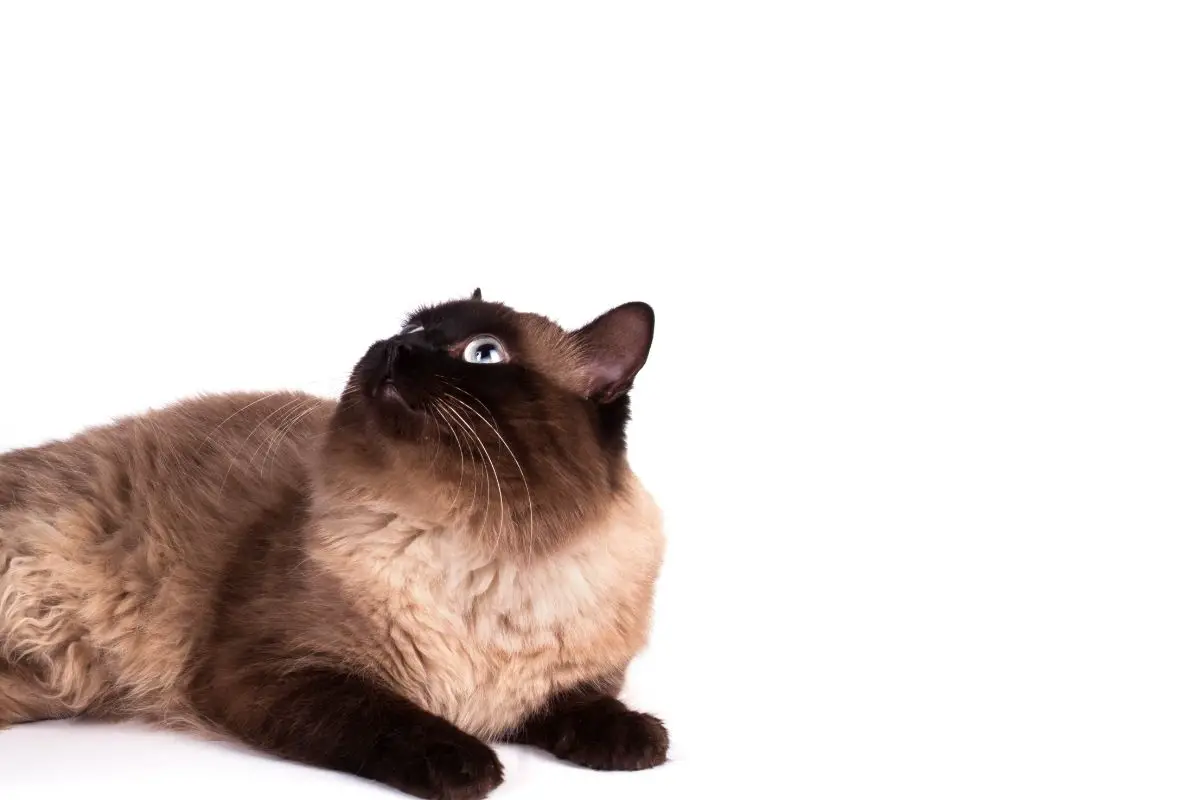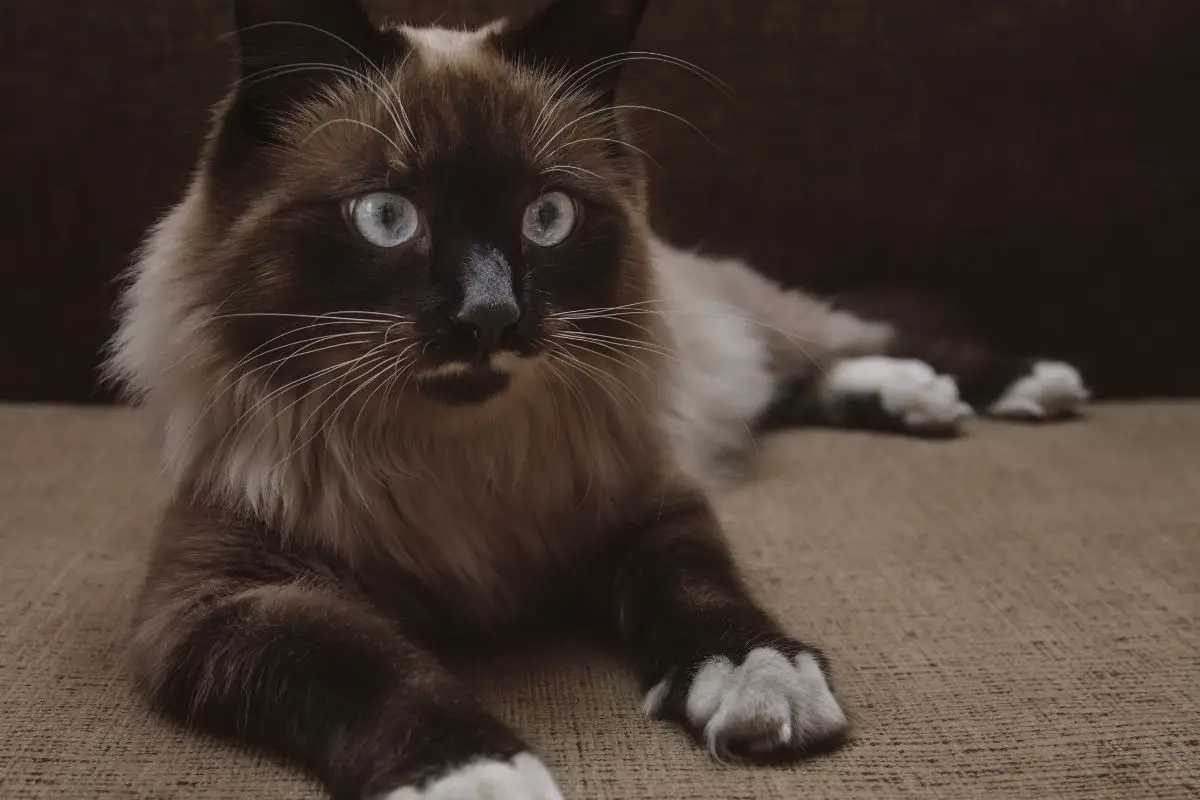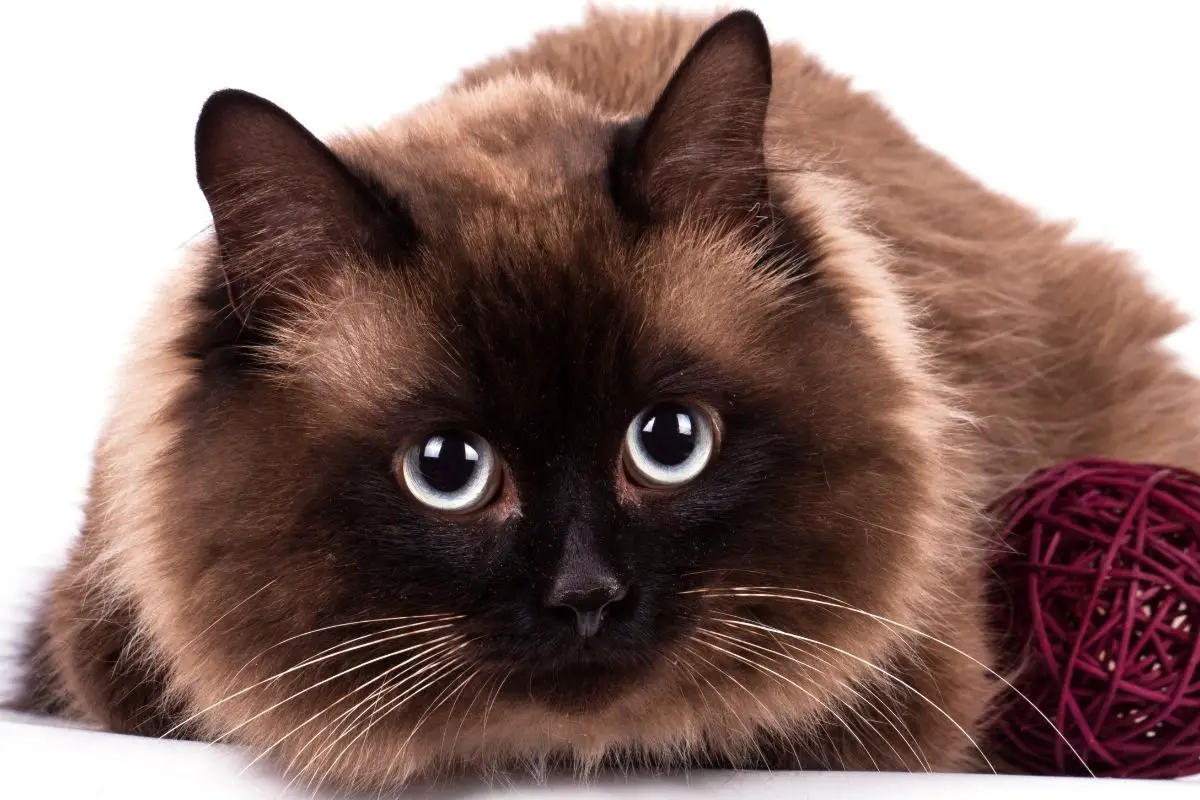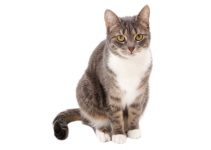Bringing home a new cat is a happy and exciting time, but before that, you’ll need to decide which cat breed will suit you.
While there are 71 different pedigree cat breeds, there are plenty more breeds that originated as crosses between established breeds.
One such breed is the Ragamese cat, which is quickly becoming one of the most popular cat breeds amongst cat lovers.
If you’re interested in owning a beautiful, energetic, yet good-tempered cat, a Ragamese might be the best choice for you.
This is a complete guide to Ragamese cats for potential owners.
We’ll be covering the genetic profile behind the Ragamese cat, what these cats are like to interact with, any health issues to consider, how much you can expect to pay for a Ragamese cat, and more!
Contents
What Is A Ragamese Cat?
The Ragamese cat is a crossbreed of two well-known cat breeds: The Siamese and the Ragdoll.
As its name suggests, this hybrid cat has characteristics from both of those breeds.
Both the Siamese and the Ragdoll parent must be purebred in order to create a true Ragamese cat.
Ragamese cats are long-haired breeds, so they are not the most low-maintenance option, especially if you’re considering adopting your first cat.
However, they love attention and enjoy playing games with their owners.
They are vocal, communicative cats for the most part, so if you’re looking for a friendly companion to keep you company at home, this is a great choice of breed.
With that being said, there are some things you should be aware of before taking on a Ragdoll-Siamese mix, such as potential health concerns, costs, and maintenance.
If you’re thinking of bringing home a Ragamese cat, make sure to read through this article first to make sure you’re making a sensible choice.
The Personality Of The Ragamese Cat
One of the main reasons why the Ragamese breed is increasing in popularity is because of these cats’ wonderful personalities.
Of course, all cats are different and have their own unique personalities, so it’s impossible to predict with 100% accuracy what your new pet’s personality will be like.
However, getting a Ragamese cat definitely increases your chances of enjoying a positive relationship with your pet.
The reason Ragamese cats are considered to have ideal personalities is that their temperament is essentially a hybrid of its parent breeds: the Ragdoll and the Siamese.
Ragdoll and Siamese cats have very different personality profiles. In some ways, they can be considered opposites.
The Siamese cat is one of the most iconic and well-known breeds in the world. This breed dates back hundreds of years to the 12th century.
Siamese cats are known attention-seekers. They are socially outgoing and even get along quite well with dogs!
They are also very vocal and won’t hesitate to make their presence known.
On the other hand, Ragdoll cats (first bred in the 1960s) are lovers of calm, peace, and quiet.
Instead of being outgoing, Ragdoll cats tend to be placid. They can be friendly and affectionate, but they aren’t too demanding when it comes to getting attention.
They are perfectly happy with their own company and won’t be upset if you don’t shower them with affection all day long.
Because of their more reserved nature, Ragdolls don’t enjoy the company of dogs as much as Siamese cats do.
The Ragamese Cat presents with a mix of the Siamese and Ragdoll personality.
This breed is generally more relaxed and low-maintenance in terms of interaction than the Siamese cat, but it’s still very friendly.
These cats are happy to chill out by themselves but also love to cuddle and play.
If you have considered bringing home a Siamese cat but aren’t sure you have the time and energy to dedicate to such a demanding breed, a Ragamese cat might be the next best choice.
Ragdoll cats are a little too autonomous for some people’s taste, but the Ragamese breed occupies a healthy middle ground.
It’s worth noting that Ragdoll cats, while fairly placid and well-behaved, are less trainable than Siamese cats.
This is because Siamese cats, despite being stubborn, usually view training sessions as a form of playtime, which they enjoy and respond well to.
This doesn’t mean that you couldn’t train a Ragdoll cat, but you have to be very careful because of how sensitive this breed is.
You should not use negative reinforcement to train any cat breed, but Ragdolls can be especially sensitive to their owners’ disapproval, so you would need to make sure that you always lead with positivity when training your Ragdoll.
Ragamese cats are more trainable than Ragdoll cats because they aren’t as sensitive.
While they may not be quite as enthusiastic about training compared to Siamese cats, this breed is more likely to take training sessions seriously and not as a game.
How Expensive Are Ragamese Cats

When it comes to bringing a Ragamese cat into your home, you have several options.
Many people assume that because Ragamese cats are a cross between two purebred breeds, you can only get them from breeders.
However, this isn’t necessarily the case, so you should consider all of your options before you choose a route because the cost difference can be significant.
Most people who decide to get a Ragamese cat choose to buy a kitten from a breeder.
This is for various reasons.
First of all, it’s true that Ragamese cats are easier to find through breeders (although, again, this is not the only choice).
Secondly, many owners find it easier to introduce a kitten into their home because older cats can be more stuck in their ways and may find it more difficult to adapt to a new home.
The average price of a Ragamese kitten (assuming it is purchased from a reputable breeder) is between $500 and $800.
Some kittens, depending on the breed, can cost up to $1,200, so while Ragamese kittens aren’t the cheapest on the market by any means, they aren’t the most expensive, either.
With that being said, there are a variety of reasons why a Ragamese cat could end up in a shelter or need rehoming.
Therefore, if you would rather not purchase a kitten from a breeder, you could try to find someone in your area who is looking for a new home for their Ragdoll-Siamese mix, or call around your local shelters to see if there is a Ragamese in need of adoption.
If you choose to purchase a Ragamese cat rather than trying to rehome or find one in shelters, please make sure to do your research beforehand and only hand over your money when you’re sure you’re dealing with a reputable breeder.
Ideally, the breeder should be willing to provide you with a full health profile for your new family member so that you can be sure that you won’t have any vet bills due to underlying health conditions in the near future.
Ragamese Cat Health Profile
Ragamese cats, like most other domestic cat breeds, have certain illnesses and diseases that they are particularly prone to.
The easiest way to determine what illnesses a cat might be likely to develop is to look at any genetic conditions that their parent breeds are predisposed to.
In the case of the Ragamese breed, the parent breeds are, of course, the Siamese and the Ragdoll.
Both have their own unique health profiles and both have several potential illnesses owners should look out for.
For example, the Siamese cat is prone to Progressive Retinal Atrophy, gum disease, urinary tract infections, and gastrointestinal issues. Meanwhile, Ragdoll cats are more likely to suffer from Hypertrophic Cardiomyopathy.
Firstly, the Ragamese cat is prone to the same infectious diseases that all domestic cats could develop without the proper vaccinations.
These include calicivirus, rabies, panleukopenia, and rhinotracheitis.
Ideally, your Ragamese should be vaccinated against these diseases by either the breeder or the shelter before you bring them home.
If not, you’ll need to make an appointment with your veterinarian at the earliest opportunity to ensure that they are fully protected.
In addition to these common diseases, Ragamese cats are prone to the following conditions:
Polycystic Kidney Disease
Polycystic Kidney Disease is a condition where multiple fluid-filled cysts accumulate in the kidneys.
These cysts put pressure on the kidneys, impairing their function and potentially leading to kidney failure after a period of time.
There is currently no cure for PKD in cats, so treatment usually involves medication and IV fluids to manage the symptoms and extend the prognosis.
The earlier the condition is diagnosed, the more chance your cat has of being able to live for several more years.
Therefore, it’s important to be aware of the symptoms.
Cats with Polycystic Kidney Disease will probably drink and urinate more than usual.
There might also be blood in the urine. Additionally, your cat may show less interest in food, vomit, or be more lethargic.
Weight loss can occur as a result.
High blood pressure is another symptom, although this isn’t something you’re likely to notice yourself at home.
Urinary Tract Infection
A urinary tract infection may sound like a relatively minor condition considering that it’s quite common and treatable in humans.
It is also a treatable condition in cats, but it’s very important to notice any symptoms and make a diagnosis early because there can be serious consequences for your cat if this condition is left untreated.
Urinary tract infections occur when bacteria makes its way into the urinary tract.
If treatment is not administered, the infection can cause a urinary blockage, which is a potentially fatal condition.
The infection may also spread to the bladder or kidneys, creating an even more urgent situation.
The main signs of UTI in cats include straining in the litter box, potentially accompanied by crying out in pain.
You might simply notice a decrease in urinary output, and there might be blood in the urine.
Your cat might also begin to urinate in places it shouldn’t.
This is because the cat may associate the litter box with pain if it is experiencing discomfort when urinating.
Gastrointestinal Issues
It’s not uncommon for cats of all breeds to experience some stomach problems now and again.
However, long-haired breeds like the Ragamese can be more prone to such issues because they are more likely to swallow hair.
The main result of a cat ingesting hair is usually hairballs or vomiting.
Unless this is happening consistently (in which case, the constant vomiting may lead to dangerous dehydration), this typically is not a cause for too much concern.
However, hair can also carry a lot of bacteria, so consuming a lot of hair can also cause an upset stomach due to the germs.
Hypertrophic Cardiomyopathy
Hypertrophic Cardiomyopathy is a hereditary condition that Ragamese cats inherit from the Ragdoll side of their parentage.
This is a type of heart disease where the walls of the left ventricle thicken. This makes the total area of the heart cavity smaller and causes the muscles to relax.
The heart then overcompensates by pumping blood at a faster rate. This can lead to arrhythmia, blood clots, or even congestive heart failure.
If congestive heart failure develops, most cats have a life expectancy of between 6 and 18 months.
Hypertrophic Cardiomyopathy is not always obvious in terms of symptoms, but if you notice that your cat is having difficulty breathing or is breathing excessively fast through the mouth (panting), you should mention your concerns to your vet.
If blood clots develop, there may be pain or paralysis of the hind legs.
Progressive Retinal Atrophy
Because Siamese cats are prone to Progressive Retinal Atrophy, Ragamese cats may also develop this condition.
With PRA, the photoreceptor cells in a cat’s retinas gradually deteriorate, eventually leading to blindness.
This is not a reversible condition and there is no cure at the moment, so all you can do as an owner if your Ragamese does develop PRA is make adjustments around your home to help your cat adjust to sightless living.
High-Rise Syndrome
Ragamese cats are more adventurous than their Ragdoll parents. They get their sense of adventure and curiosity from their Siamese parentage.
Because these cats like to explore, they may be more prone to High-Rise Syndrome, which is simply a more formal way of saying that Ragamese cats might be more likely to fall from high places and sustain injuries.
If you have a Ragamese cat, it is best to keep them away from areas like balconies.
It’s also important not to let them climb out of windows if you live in a multi-story building.
Most commonly, falling from a high place may result in your cat sustaining broken bones, especially in the jaw and legs.
However, if the fall is severe enough, there may be damage to the internal organs such as the lungs.
Heartworm
Heartworm is a parasitic infection carried by mosquitoes.
This condition causes serious damage to the lungs and because the medication that has been developed to cure the illness is not approved for felines, there is no cure.
Cats with heartworm may present with labored breathing, rapid breathing, coughing, loss of appetite, and weight loss.
Ragamese Cat Shedding

Because Ragamese cats have long, luscious fur, they can be slightly more prone to shedding than other domestic cat breeds.
With that being said, many owners report that their Ragamese cat does not shed noticeably more than any other cat breed.
Ragamese cats shed primarily during the Spring and the Fall.
This is because they shed their Winter coats when the weather starts to warm up and shed again to prepare for their Winter coat during the colder months.
This means that you’re likely to notice more shedding during these times and minimal shedding in between.
The key to keeping your Ragamese cat’s shedding manageable is grooming them regularly.
This will help to ensure that their coat remains silky and smooth and prevents any matting.
Combing through their fur at least twice a week will also make sure that any loose hairs are removed in a controlled manner instead of shedding all over your home.
While grooming your Ragamese cat, it’s also important to clean their eyes and ears.
As we mentioned earlier, long hair on a cat can increase the risk of bacterial consumption.
However, it can also cause bacterial buildup in other areas such as the eyes and ears if they are not cleaned properly.
Regular cleaning will stop germs from accumulating in your cat’s ears and eyes, minimizing the risk of infection.
Using this time to trim your cat’s claws could also make your Ragamese’s maintenance easier.
Final Thoughts
The Ragamese is an interesting breed of cat. While they are known for their calm nature, they are also friendly, adventurous, and intelligent.
If you want a playful, inquisitive cat, then you should consider getting one of these friendly creatures.
Hopefully, the information above will help you to be more informed about grooming requirements, health conditions, initial costs, and the Ragamese temperament before you bring home your new friend.
Learn more by reading other interesting articles about Cats here.



